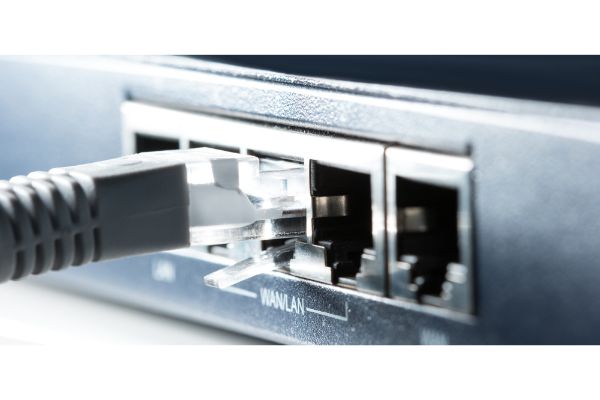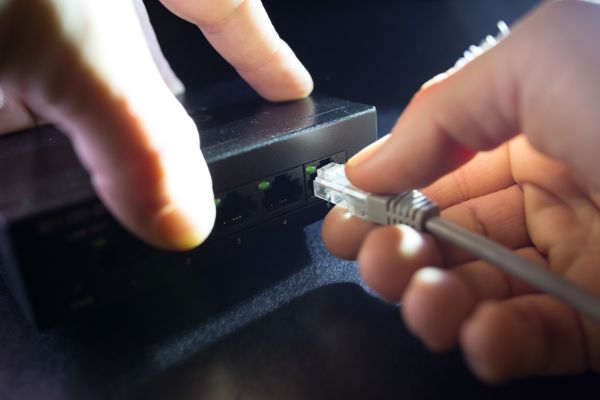Disclaimer: This post may contain affiliate links, meaning we get a small commission if you make a purchase through our links, at no cost to you. For more information, please visit our Disclaimer Page.
Wireless connectivity is probably the most common way that people connect to the internet around the globe. We set up our own Wi-Fi networks at home for our computers and other devices. Furthermore, many companies create local Wi-Fi networks to get all of the computers the employees might use online. Even our smartphones and tablets need networks without physical wires in order to access the web.
However, a good Wi-Fi network is not the only way to get online. Some people may want to create a physical connection, and they can do this through an ethernet cable. This might be particularly true for people who only need to connect one, dedicated computer to the internet. An ethernet cable gives you hardwired access to the internet by making a solid connection between your main device and a router or modem. In general, it might give you a more stable line.
Some users who are looking to this mode of connectivity wonder if ethernet cables can or do carry electricity. We will ponder this question in today’s article. As we do, we will consider whether the amount of electricity you might find in an ethernet cable can give you a shock, whether the cable can carry a surge of power to your devices, and talk about things like adding surge protection or unplugging physical cables during a storm.
Table of Contents
Do Ethernet Cables Carry Electricity? (Can It Shock You?)
Yes, ethernet cables sometimes carry electricity through them. Typically, the amount that they will have in them should be small, and it may be something you notice only when the cable is supposed to be sending data packets at extremely high frequencies. Even so, some power needs to go through the cable in order for it to achieve this transfer.
The voltage that goes through an ethernet cable should not be particularly high, and it should only occur after the cable meets with the power supply and actually needs to start sending data. Once this happens, there is some low voltage on the wires.
For the most part, it should be low enough that most people would not consider it to be a true electrocution hazard. However, each rule comes with caveats.
There is always a small risk of some kind of more powerful current could travel through the wires at any given time. In most cases, this risk may be at its highest during a lightning storm. Direct lightning power may be able to travel through the main source and up through the ethernet cable.
When this happens, the accessory may be able to provide a bigger shock to a person. Just how big a shock it can carry is hard to define, but the possibility exists. Under normal operations, this kind of thing should not be a big worry for most users.
Can an Ethernet Cable Carry a Power Surge?
A power surge is a bit different from the normal voltage that an ethernet cable might carry once it talks with a power source. While the usual voltage should not be a hazard, the power surge is a different matter.
A power surge happens when far more voltage than is normal comes through your devices. The usual way that this happens is via the different cables that connect to said devices. Therefore, it is possible for an ethernet cable to carry a surge like this.
Having said that, we should still discuss the likelihood of this kind of thing happening with ethernet cables. As with any electronic device and the cables connected to it, a surge of power is possible, but the design of most ethernet cables makes it less likely for them to carry the surge to the device.
In most cases, the surge will happen because the power supply itself got a voltage charge that damaged other parts of your equipment. Ethernet cables simply don’t have design elements that allow them to carry very much power. Most modern cables of this type have several twists in their wiring setups. These twists make the circuitry inside the wires quite resistant to external problems that might occur when surges happen.
Should I Unplug an Ethernet Cable During a Thunderstorm?
Although some of the answers to this question can vary from one individual to another, you can’t go wrong in unplugging some of your tech during a thunderstorm. When we say unplug, we’re talking about unplugging devices or power strips from your main power sources and wall outlets.
Before we dive a little deeper, it is worth noting that not all thunderstorms produce heavy lightning. Lightning is the true culprit that you want to watch out for here, but thunder without lightning should not be a huge problem.
We will assume you are dealing with a storm that includes quite a few bolts of lightning that you can see in your general area. Lightning carries phenomenal amounts of energy in each bolt.
It is very easy for one lightning strike to overload systems or some of your connected devices quickly. Even if your computer does not have an active connection to your main power, damage could still occur.
For example, you may decide to unplug your laptop and run it off of its battery power during a storm. If the device still uses a hard ethernet connection to get internet access, a heavy enough lightning strike could cause a large voltage spike that sends damaging electricity through your laptop.
If you need to work during a storm like the one we’ve described above, it is still a good idea to unplug your ethernet cable. In many cases, you could still connect your computer to the internet wirelessly to continue the work you need to do.
This frees your device from both main power and an ethernet connection, either of which could do some damage if they get too high a current running through them. If you are not able to access the internet on your computer without a hard connection, consider switching to a different device that can, at least until the storm passes.
Do You Need a Surge Protector for Ethernet?
Surge protection is always a good idea, but you don’t really need it for ethernet cables.
This is because the cables come with tiny transformers on the ends of them. These transformers isolate the cables from the power that goes through end devices like a computer or router.
Manufacturers include these transformers mostly as a way to make sure data transference jobs don’t see any interference in their signals. However, they have the additional side benefit of protecting the end equipment from surges, too.
Most power lines have their own surge protection that should stop most of these spikes from getting through. For a power surge to be that damaging to the ethernet, it would have to be so strong that it blows out those transformers.
The increased voltage spike would then travel across the blown ethernet cable to go into the end devices, and this action is what might cause some damage.
A lightning strike itself would be more problematic than a typical power surge. Adding some kind of protection for the ethernet itself could degrade your signal quality unnecessarily, too.
However, that doesn’t mean that surge protection is pointless. Good protection in this category can always offer some way to shield your end devices. If possible, you should purchase surge protection units that you can plug devices like laptops or desktops into directly.
This would be more helpful than doing something to protect the ethernet line itself, although strikes that go through and burn this line are always a possibility.
Where Do You Put an Ethernet Surge Protector?
With all that said, you can purchase additional surge protection that connects to ethernet cables, too. Special ethernet surge protectors will be quite similar to the more typical ones you will find on the market, but they will have openings to accommodate the ends of these cables.
This expands the functionality of the surge protector, and it may be a good option for people who need to keep their computers connected to the internet via physical wiring instead of Wi-Fi.
Although you have some choices here, perhaps the best place for an ethernet surge protector is near a wall outlet that allows it to reach other devices. Most ethernet cables are quite long, so you should have no trouble in getting a protector that can accommodate your wiring, even if it happens to be further away from your end device.
With the proper placement, you can use the surge protector to plug in and protect other devices that also need to maintain their power levels during a storm.
Does a Surge Protector Affect Internet Speed?
Ordinarily, a surge protector that developers make to precise and high standards should not have an impact on your internet speed.
If there is one, the drop in speed should be minimal. Further, this kind of thing should only happen if you plug a modem or router into the surge protector instead of just to the main wall outlet.
So, while it is possible that a networking device that runs through a surge protector could drop its speed as it passes through the shield, you should not see much of a difference. If you do, the protector itself may not be of high enough quality.
Conclusion
Wi-Fi is a great resource when you have access to it, but sometimes you need that physical connection to the internet. The standard ethernet cable can give this kind of connection to your computer. In most cases, it only carries a very low voltage rate when it needs to get some power to send data, and most manufacturers insulate their cables well.
This means that the chances of either electrocution or surges that can damage devices via the ethernet cable itself should be low. Even so, you can still purchase surge protection devices that are compatible with these cables.


